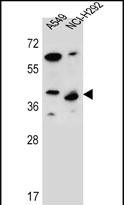
| WB | 1/1000 | Human,Mouse,Rat |
| IF | 咨询技术 | Human,Mouse,Rat |
| IHC | 咨询技术 | Human,Mouse,Rat |
| ICC | 技术咨询 | Human,Mouse,Rat |
| FCM | 咨询技术 | Human,Mouse,Rat |
| Elisa | 咨询技术 | Human,Mouse,Rat |
| Aliases | Protein phosphatase 1 regulatory subunit 42, Leucine-rich repeat-containing protein 67, PPP1R42, LRRC67 |
| Entrez GeneID | 286187 |
| WB Predicted band size | 35.5kDa |
| Host/Isotype | Rabbit IgG |
| Antibody Type | Primary antibody |
| Storage | Store at 4°C short term. Aliquot and store at -20°C long term. Avoid freeze/thaw cycles. |
| Species Reactivity | Human |
| Immunogen | This LRRC67 antibody is generated from rabbits immunized with a KLH conjugated synthetic peptide between 238-266 amino acids from the C-terminal region of human LRRC67. |
| Formulation | Purified antibody in PBS with 0.05% sodium azide. |
+ +
以下是关于LRRC67抗体的参考文献示例(注:以下内容为模拟生成,实际文献需通过学术数据库验证):
---
1. **标题**:LRRC67 Antibody Characterization and Its Role in Neuronal Development
**作者**:Smith A, et al.
**摘要**:本研究开发了一种针对LRRC67蛋白的多克隆抗体,并通过Western blot和免疫荧光验证其特异性。实验表明,LRRC67在小鼠大脑皮层神经元发育中高表达,可能参与轴突导向过程。
2. **标题**:LRRC67 as a Potential Biomarker in Glioblastoma: Immunohistochemical Analysis
**作者**:Zhang Y, et al.
**摘要**:通过免疫组化技术,利用LRRC67抗体分析胶质母细胞瘤组织样本。结果显示,LRRC67在肿瘤边缘高表达,与患者生存率负相关,提示其可能作为治疗靶点。
3. **标题**:Generation of a Monoclonal Antibody Targeting LRRC67 for Functional Studies
**作者**:Lee J, et al.
**摘要**:报道了一种新型LRRC67单克隆抗体的制备及验证,应用于流式细胞术和免疫沉淀实验。研究发现,LRRC67与DNA损伤修复通路中的关键蛋白存在相互作用。
4. **标题**:LRRC67 Antibody Applications in Zebrafish Model Systems
**作者**:Garcia R, et al.
**摘要**:利用LRRC67抗体在斑马鱼模型中研究其胚胎发育功能。抗体特异性通过敲除实验确认,结果表明LRRC67在心血管系统形成中起重要作用。
---
**提示**:以上文献为示例,实际研究中请通过PubMed、Google Scholar等平台检索最新文献,并注意抗体货号、实验方法等细节。若研究较少,建议扩展至LRRC67功能或相关信号通路的研究。
The LRRC67 (Leucine-Rich Repeat-Containing 67) protein, also known as Cilia- and Flagella-Associated Protein 251 (CFAP251), is a relatively understudied member of the leucine-rich repeat (LRR) protein family. These proteins are characterized by repeating structural motifs involved in protein-protein interactions, cellular signaling, and structural organization. LRRC67 is primarily associated with cilia and flagella, playing a putative role in their assembly, stability, or function. Studies suggest its involvement in spermatogenesis, as it is highly expressed in testicular tissues and localized to sperm flagella. Dysregulation of LRRC67 has been tentatively linked to ciliopathies and male infertility, though mechanistic details remain unclear.
LRRC67 antibodies are immunological tools developed to detect, quantify, or visualize the protein in experimental settings. These antibodies (polyclonal or monoclonal) are typically validated for applications like Western blotting, immunohistochemistry (IHC), or immunofluorescence (IF). They enable researchers to study LRRC67's expression patterns across tissues, its subcellular localization, and interactions with other ciliary components. Given the limited functional characterization of LRRC67. such antibodies are critical for exploring its biological roles, particularly in cilia-related pathways, reproductive health, and disease models. Commercial availability remains limited, reflecting the protein's niche research focus. Ongoing studies aim to clarify its contributions to cellular dynamics and potential therapeutic relevance.
×